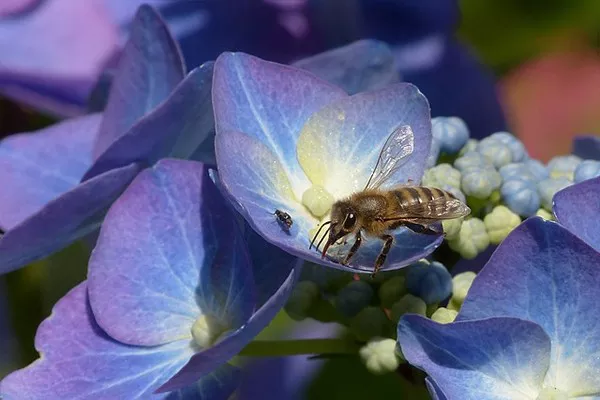Bees play a vital role in our ecosystem, pollinating plants essential for food production and sustaining biodiversity. However, bee populations worldwide are under threat due to factors like habitat loss, pesticide use, and climate change. One effective way to support bee populations is by planting bee-friendly flowers in gardens, parks, and green spaces. In this article, we will explore the best flowers to plant to attract and support bees, helping to promote their health and well-being.
Understanding Bee Foraging Behavior
Before delving into specific flower recommendations, it’s essential to understand bees’ foraging behavior. Bees, particularly honeybees and native solitary bees, rely on flowers for nectar and pollen, which they use as food sources. Nectar provides carbohydrates for energy, while pollen offers essential proteins and nutrients. Bees are attracted to flowers with vibrant colors, particularly blue, purple, and yellow hues, as these colors are easily visible to them.
In addition to color, bees are drawn to flowers with certain characteristics:
1. Flower Shape: Bees prefer flowers with open, shallow blossoms that allow easy access to nectar and pollen. Examples include daisies, sunflowers, and asters.
2. Fragrance: While humans may prioritize scent, bees are more attracted to flowers with strong fragrances, which help them locate nectar-rich blooms.
3. Continuous Blooming: Bees require a consistent food supply throughout the growing season. Therefore, planting a variety of flowers that bloom at different times ensures a continuous food source for bees.
Now, let’s explore some of the best flowers to plant to support bee populations:
Lavender (Lavandula spp.)
Lavender’s fragrant, purple blooms are a favorite among bees, attracting a variety of species.
This perennial herb blooms from late spring to early fall, providing bees with a steady food source.
Its drought tolerance and resilience make it an excellent choice for garden borders, rock gardens, and containers.
Sunflowers (Helianthus spp.)
Sunflowers’ large, cheerful blooms are not only attractive to humans but also highly appealing to bees.
These annual plants produce abundant pollen and nectar, making them a valuable resource for bees.
Varieties with single, pollen-rich flowers are particularly beneficial to bees, as they provide easy access to nectar and pollen.
Bee Balm (Monarda spp.)
As the name suggests, bee balm is a favorite among bees, attracting both honeybees and native pollinators.
This perennial herbaceous plant produces clusters of tubular flowers in shades of pink, red, purple, and white.
Bee balm blooms from mid- to late summer, providing bees with a rich source of nectar.
Cosmos (Cosmos spp.)
Cosmos flowers feature delicate, daisy-like blossoms that are highly attractive to bees and other pollinators.
These annual plants bloom profusely from early summer to fall, providing bees with a long-lasting food source.
Cosmos varieties come in a range of colors, including white, pink, and deep burgundy, appealing to different bee species.
Bluebonnet (Lupinus spp.)
Native to North America, bluebonnets are an excellent choice for supporting local bee populations.
These perennial wildflowers produce spikes of blue, purple, or white flowers in the spring, attracting bees and other pollinators.
Bluebonnets thrive in sunny, well-drained locations and are drought-tolerant once established.
Purple Coneflower (Echinacea purpurea)
Purple coneflower is a hardy perennial native to North America, known for its medicinal properties and bee-attracting blooms.
Its purple-petaled flowers with prominent orange central disks provide abundant nectar and pollen for bees.
Purple coneflower blooms from midsummer to early fall, extending the bee foraging season.
Borage (Borago officinalis)
Borage is a versatile herb with attractive blue, star-shaped flowers that bees find irresistible.
This annual or biennial plant blooms from late spring to early fall, providing bees with a long season of nectar and pollen.
Borage is also valued for its edible leaves and cucumber-flavored flowers, making it a dual-purpose plant for both humans and bees.
Sage (Salvia spp.)
Sage plants, including culinary varieties like common sage (Salvia officinalis) and ornamental species, are highly attractive to bees.
Their tubular flowers, available in shades of blue, purple, pink, and white, provide abundant nectar for bees.
Sage blooms from spring to fall, with some species flowering even into winter in milder climates, ensuring year-round forage for bees.
Wild Bergamot (Monarda fistulosa)
Also known as bee balm or wild oregano, wild bergamot is a native perennial with lavender-pink flowers that bees adore.
Its fragrant blossoms attract a variety of bee species, including honeybees, bumblebees, and native solitary bees.
Wild bergamot blooms from mid- to late summer and thrives in sunny to partially shaded locations with moist, well-drained soil.
Catmint (Nepeta spp.)
Catmint, a member of the mint family, produces clusters of small, lavender-blue flowers that bees find irresistible.
This perennial herb blooms from late spring to early fall, providing bees with a continuous source of nectar.
Catmint is low-maintenance and drought-tolerant once established, making it an ideal choice for bee-friendly gardens.
Conclusion
Planting bee-friendly flowers is a simple yet impactful way to support bee populations and promote pollinator health and biodiversity. By selecting a diverse range of flowers that bloom throughout the growing season, gardeners can create habitats that attract and sustain bees, ensuring their vital role in pollination and ecosystem stability. Whether you have a small urban garden or a sprawling countryside landscape, incorporating bee-friendly flowers is a rewarding endeavor that benefits both bees and humans alike. Let’s work together to create bee-friendly spaces and safeguard these essential pollinators for generations to come.


